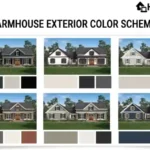Picture this: You’re strolling down a tree-lined street when suddenly, a house catches your eye. Its steeply pitched roof, intricate brickwork, and charming half-timbered facade transport you to another era. Yet, there’s something undeniably modern about it. Welcome to the world of the modern Tudor style house, where centuries-old charm meets contemporary living.
The Tudor style house has captivated homeowners and architecture enthusiasts for generations. But what makes this style so enduring? How has it evolved to meet the needs of modern families while still maintaining its distinctive character? In this comprehensive guide, we’ll explore the fascinating world of modern Tudor style houses, from their rich history to their unique features and the benefits they offer to today’s homeowners.
The Evolution of Tudor Architecture: From Medieval England to Modern America
A Brief History of Tudor Architecture
The Tudor style originated in England during the late 15th and early 16th centuries, under the reign of the Tudor monarchs. This period saw a shift from medieval architecture to the Renaissance style, resulting in a unique blend of features that would come to define the Tudor aesthetic.
The Rise of Modern Tudor Style Homes
Fast forward to the early 20th century, and Tudor Revival architecture took America by storm. Wealthy homeowners were drawn to the style’s romantic, old-world charm. Today, modern Tudor style houses continue to captivate, offering a perfect balance between historical elegance and contemporary comfort.
Key Features That Define the Modern Tudor Aesthetic
What sets a Tudor style house apart from other architectural styles? Let’s dive into the distinctive elements that make these homes so recognizable and beloved.
Exterior Features of Modern Tudor Style Houses
The exterior of a Tudor style house is its calling card, instantly recognizable and full of character. Let’s explore the key features that give these homes their unique charm.
1. Steeply Pitched Roofs
One of the most distinctive features of a Tudor style house is its dramatic roofline. These homes boast:
- Gable roofs with varying heights and overlapping gables
- Decorative half-timbering in gables, adding visual interest and texture
- Slate or asphalt shingles, often in dark colors to complement the overall aesthetic
The steep pitch of Tudor roofs isn’t just for show – it’s a practical design that allows for efficient water and snow runoff, making these homes well-suited to various climates.
2. Brick and Stone Exteriors
Tudor style houses are known for their robust and textured exteriors. Key elements include:
- Brick as the primary exterior material, often in warm, earthy tones
- Decorative stonework around doors and windows, adding depth and visual interest
- Stucco or stone infill between half-timbering, creating a striking contrast
This combination of materials not only adds to the home’s aesthetic appeal but also provides durability and insulation.
3. Tall, Narrow Windows
The windows of a Tudor style house are as functional as they are beautiful. Look for:
- Casement windows with multiple panes, often diamond-shaped for added charm
- Groupings of tall, narrow windows, allowing plenty of natural light while maintaining privacy
- Occasional oriel windows – projecting bay windows supported by brackets or corbels
These distinctive windows contribute to the home’s vertical emphasis and create interesting patterns of light and shadow inside.
4. Prominent Chimneys
A Tudor style house wouldn’t be complete without its eye-catching chimneys. Features include:
- Large exterior chimneys, often made of brick or stone
- Decorative brickwork and stonework, such as twisted or patterned designs
- Multiple chimneys, sometimes grouped together for a more dramatic effect
These chimneys are not just functional – they’re architectural statements that add to the home’s overall character.
5. Entrances and Doors
The entryway of a Tudor style house is designed to make a lasting impression. Key elements include:
- Asymmetrical placement of front doors, adding to the home’s whimsical charm
- Arched doorways with rounded or flattened archtops
- Solid wood doors with decorative panels or planks
- Elaborately carved wood surrounds and trim
- Wrought iron hardware, including handles, hinges, and knockers
These entrances invite you to step into a world where every detail tells a story.
Interior Features of Modern Tudor Style Houses
Step inside a Tudor style house, and you’ll find that the interior is just as captivating as the exterior. Let’s explore the features that make these homes so inviting and unique.
1. Dark Wood Elements
The use of dark wood is a hallmark of Tudor interior design. Look for:
- Exposed wood beams on ceilings, adding warmth and character
- Wood paneling on walls, creating a cozy, intimate atmosphere
- Ornate wood detailing, such as carved moldings and trim
These elements bring a sense of history and craftsmanship to the home, creating a rich, textured environment.
2. Asymmetrical Floor Plans
Tudor style houses are known for their unique and often quirky layouts. Key features include:
- Flexibility in room heights and window placement
- Angled wings and diverse layouts that create interesting spaces
- Nooks and crannies that add charm and provide opportunities for creative use of space
This asymmetry keeps the home interesting and allows for a more organic flow between rooms.
3. Rich Color Schemes
The color palette of a Tudor style house interior is typically warm and inviting. Common elements include:
- Warm colors like red, yellow, and brown, creating a cozy atmosphere
- Elaborate draperies and rugs that add texture and depth to the space
- Rich, jewel-toned accents that complement the dark wood elements
These color choices help to create a sense of timeless elegance and comfort.
4. Cozy, Manor-like Ambiance
The overall feel of a Tudor style house interior is one of warmth and luxury. This is achieved through:
- Heavily accented interiors with dark wood and rich textures
- A sense of grandeur and luxury, reminiscent of old English manors
- Intimate spaces that encourage gathering and conversation
This combination of elements creates a home that feels both grand and welcoming.
Benefits of Modern Tudor Style Houses
Now that we’ve explored the distinctive features of Tudor style houses, let’s consider why they remain such a popular choice for homeowners today.
1. Timeless Elegance
Tudor style houses offer:
- A blend of historic charm and contemporary living
- Enduring appeal that transcends passing trends
- A unique aesthetic that stands out in any neighborhood
Owning a Tudor style house is like having a piece of history right in your own backyard.
2. Customizable Design
Despite their distinctive style, Tudor houses are surprisingly adaptable:
- They can be scaled to fit various lot sizes and regions
- Modern amenities can be seamlessly incorporated without compromising the overall aesthetic
- The style allows for personal touches and customization within its framework
This flexibility means you can have a home that’s both classic and uniquely yours.
3. Curb Appeal and Resale Value
Tudor style houses are known for their:
- Distinctive and recognizable aesthetic that sets them apart
- Strong appeal to homebuyers seeking unique character and charm
- Potential for strong resale value due to their timeless appeal
Investing in a Tudor style house can be a smart financial decision as well as an aesthetic one.
Challenges and Considerations
While Tudor style houses offer many benefits, it’s important to consider some potential challenges:
1. Maintenance and Repairs
The intricate details that make Tudor homes so beautiful can also require special care:
- Masonry and woodwork may need specialized expertise for repairs
- Maintenance costs can be higher due to the use of premium materials
- Regular upkeep is crucial to maintain the home’s character and structural integrity
2. Adapting to Modern Lifestyles
The unique layout of Tudor homes can sometimes present challenges:
- Asymmetrical layouts may require creative solutions for modern living spaces
- Balancing historic charm with contemporary needs can be a delicate process
- Energy efficiency may need to be addressed in older Tudor homes
3. Cost of Construction
Building a new Tudor style house or renovating an existing one can be more expensive than other styles:
- High-quality materials and labor-intensive construction can drive up costs
- Specialized craftsmen may be needed for authentic details
- Potential for higher construction costs compared to more standardized home styles
The Future of Tudor Style Houses: Embracing Tradition in a Modern World
| Aspect | Traditional Tudor | Modern Tudor |
|---|---|---|
| Materials | Primarily wood, brick, and stone | Incorporation of modern, sustainable materials |
| Layout | Closed floor plans, separate rooms | Open concept living areas with Tudor aesthetics |
| Energy Efficiency | Often drafty and less efficient | Improved insulation and energy-saving features |
| Technology | Limited integration | Smart home features seamlessly incorporated |
| Sustainability | Not a primary concern | Eco-friendly practices and materials prioritized |
As we look to the future, Tudor style houses continue to evolve, adapting to modern needs while preserving their timeless charm. Homeowners and architects are finding innovative ways to:
- Incorporate sustainable materials and energy-efficient technologies
- Create open-concept living spaces that maintain Tudor character
- Blend smart home features with traditional Tudor aesthetics
These adaptations ensure that Tudor style houses will remain relevant and desirable for generations to come.
Related Article : Top 10 Budget-Friendly Home Renovations
Conclusion: The Enduring Appeal of Tudor Style Houses
In a world of ever-changing architectural trends, the Tudor style house stands as a testament to timeless design. Its distinctive features – from steeply pitched roofs to charming half-timbered facades – continue to captivate homeowners and passersby alike.
Modern Tudor style houses offer a unique blend of historical charm and contemporary comfort. They provide a canvas for personal expression while maintaining a connection to architectural heritage. Despite the challenges of maintenance and adaptation, the benefits of owning a Tudor style house – including its timeless elegance, customizable design, and strong curb appeal – make it a compelling choice for those seeking a home with character.
As we move forward, the Tudor style will undoubtedly continue to evolve, embracing new technologies and sustainable practices while preserving the core elements that make it so beloved. Whether you’re drawn to its romantic aesthetic, its rich history, or its potential for modern living, a Tudor style house offers a unique and rewarding homeownership experience.
So, the next time you find yourself captivated by a Tudor style house, remember – you’re not just looking at a building, but a piece of living history, adapted for the present and ready for the future. Will your next home be a modern Tudor masterpiece?

